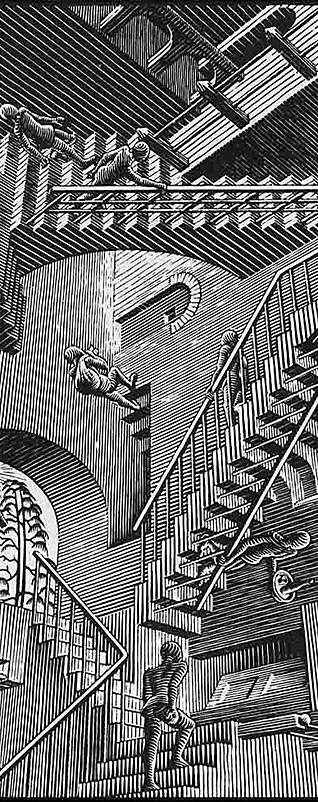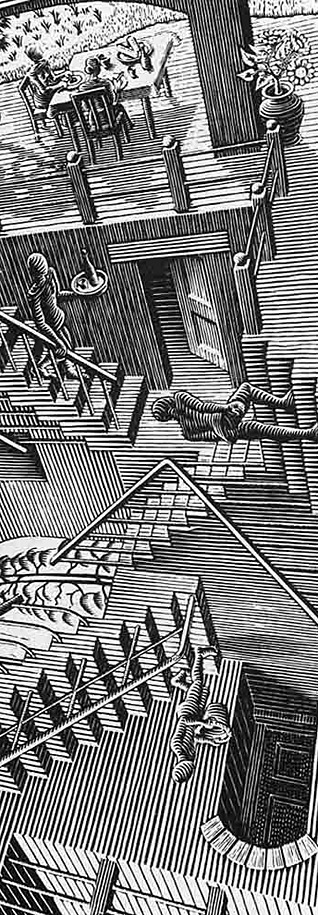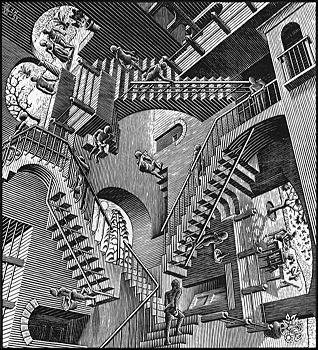Faith
Standing Logic On Its Head
by I.J. SINGH & MANJYOT KAUR
Analogies go only so far. To push them further doesn't serve reason very well, but the temptation is often hard to resist. This is surely true of interfaith comparisons.
We are going to illustrate our concerns by some obvious and some not-so-obvious examples of stretching reason beyond the elasticity inherent in it.
Our thought process in this case started with contemplating the janaeu, the so-called "sacred thread" which upper-caste Hindu males wear diagonally across their torso. Guru Nanak, the founder of Sikhism, rejected it and refused to wear it when it was proffered to him in a coming-of-age ceremony when he was around 12 years old.
The thread was not available to any females or to those males who came from the lowest rung of the Hindu caste system, the Sudras. The number of strands in the twisted thread varied according to caste - the Brahmin rating more than the Kshatriya and Vaisya. For Brahmins, the thread was made of cotton, for Kshatriyas, it was of hemp, and for Vaisyas, wool. Boys from Brahmin families underwent this rite-of-passage sometime between the ages of five and eight, Kshatriya boys between the ages of nine and twelve, and Vaisyas at a slightly older age.
Nanak's words at that time, which form an unforgettable hymn in the Guru Granth, recognized that the janaeu had become the focal point of a discriminatory and divisive ritual.
Instead of wearing a mere thread, which could break or become soiled, Guru Nanak advised:
Out of the cotton of compassion,
Spin the thread of contentment,
Tie the knot of continence,
Give it the twist of virtues;
Make such a sacred thread
O Pundit, for your inner self.
Such a thread will not break,
Nor get soiled, be burnt, be lost,
Blessed is the man, O Nanak,
Who makes it part of his life.
This cotton thread, for a penny you buy
Sitting in a square, mud-plastered,
You put it around the necks of others.
In the ears some words you whisper, O Brahmin,
And claim to be a spiritual teacher.
With death of the wearer falls the thread,
Thus without the thread he departs from the earth.
[GGS:471]
The Tenth Master, Guru Gobind Singh, enjoined Sikhs to wear five Kakaars, or articles of faith, among which are Kesh, i.e., long, unshorn head hair, including an untrimmed beard for men, and fully intact hair wherever it appears on the body; a sword (Kirpan); and a steel bracelet (Kara).
Not surprisingly, there are Sikhs who find some of these requirements onerous, perhaps outmoded and unnecessary in this day and age. And they often cast their arguments imaginatively.
Isn't it true, they ask, that the kirpan is required only of Amritdhari Sikhs - those who have been formally initiated into the faith - and not of the many that are not? As a weapon, they continue, isn't it surely overrated in this day of handguns and Uzis? And didn't Guru Gobind Singh decree that Sikhs should wear a kirpan simply because in those days, enemies surrounded them and they never knew when the foe would strike next?
So, according to these doubting Thomases, hasn't the kirpan, worn strapped into its gatra, become our janaeu that hangs as a useless, anachronistic relic around us?
Similarly, for the long, unshorn hair and the turban. Some are tempted to argue that, if it is permissible to reduce the length of one kakkar - the kirpan - from its full size of three feet to a mere several inches, for the sake of practicality and comfort of the wearer, why can't the same be done with another Kakkar - our Kesh - to enhance the wearer's ease and convenience?
And, as some naysayers would further continue, don't some Sikhs who keep kesh believe that, on the weight of this factor alone, they are somehow superior to those who have chosen to cut their hair and discard the turban? So then, they ask, how is kesh different from the janaeu of the Hindus that Guru Nanak rejected?
As for the kara, for some Sikhs who sport one made of gold, isn't it a way to proclaim one's personal wealth (or that of one's parents or in-laws)? For many others, it seems to have taken on a protective guise: much as the wearer of the janaeu was supposedly safeguarded by the Hindu gods and goddesses, the kara is deemed to supernaturally invoke the protection of the Guru. So how is it different from the upper-caste Hindu thread, some would argue?
We think that such reasoning is facile, but false. It pushes the analogy beyond its limits and stands logic on its head. There are some fundamentals being sidestepped here. It must be kept in mind that the significance of these markers is not readily transferable from one tradition to the other.
A major difference between the janaeu and the Sikh articles of faith is that the janaeu, at least to the ordinary follower, promises rewards in this life or the hereafter, and invokes safety for the wearer from various dangers and sources of evil.
Clearly, none of the Sikh symbols possess these putative attributes. While they are indeed powerful connecting links to centuries of Sikh history and the glorious heritage of our Gurus, they do not promise that the wearer will thereby attain nirvana, become privy to special knowledge, or gain divine protection. These primordial distinctions must stay paramount in one's mind.
We readily concede that the kirpan remains both a symbol and a weapon. As the latter, it was considered utilitarian in the era of Guru Gobind Singh, when Sikhs were constantly liable to attacks by omnipresent enemies. Although the times may have diminished its importance as an arm, it endures as a potent reminder of the ever-present need for justice and courageous resolve.
Unlike the janaeu, which serves to separate and differentiate between fellow human beings, the kirpan - which stands for a Sikh's commitment to defend and uplift the oppressed and downtrodden - recognizes the inherent unity and equality of all mankind. These attributes must not be underestimated.
It is also true that many Sikhs who wear long, unshorn hair and a turban have little or no understanding of the meaning and magic of the more than 300 years of unbroken tradition that mandates them, and their lives have little or no connection to Sikhi. The requirement that all hair on head and body be left fully intact is not different for different Sikhs; for all Sikhs, it is universal. In keeping with the gender equality that lies at the core of Sikhi, the injunction applies equally to females.
Unlike the number of strands mandated for the Hindu janaeu, the long hair or turban does not vary with the wearer's social status. In a timeless and universal way, Kesh remains - and will always remain - the pre-eminent marker of the Sikh faith.
The kara is a kakkar commonly worn by most Sikhs, regardless of their degree of personal observance. It symbolizes, among other things, the necessity of righteous action, as well as the wearer's attachment and fidelity to the Guru (like a wedding ring). It is meant to be a simple wristband of steel or sarbloh.
Wearing a kara made of a precious metal, such as gold, perverts its true meaning and reduces it from an article of faith to a showy adornment or item of jewelry.
Simplistic comparisons are easily propounded, but almost always remain of minimal value. These types of analogies, especially in matters of religion, must not be pushed too far or too fast. Even a flexible balloon will surely burst when over-inflated beyond its elasticity.
Symbols like unshorn hair and turbans, kirpans, and karas are too substantial and powerful to ignore. Their connection to who we are and the ideals we must continually strive for is too obvious to miss. These markers are tangible and real. And that is how they serve their purpose and maintain their relevance in our modern, everyday lives.
Remaining ever vigilant that these articles of faith not get debased or morph into janaeus around our necks now becomes our onus.
[Gurbani translation from The Sacred Writings of the Sikhs by Trilochan Singh et al., UNESCO-Orient Longman, 1960, p 92]
September 11, 2009
Conversation about this article
1: Harinder (Bangalore, India), September 11, 2009, 9:27 AM.
The 5Ks are not required by the Guru Granth. Therefore, my opinion is that it has only historical significance.
2: Chintan Singh (San Jose, California, U.S.A.), September 11, 2009, 1:15 PM.
I have myself struggled with this one - whether in this day and age, the kirpan and the other four kakaars are necessary for Sikhs to wear or not. My conclusion over a period of time is, as the intimacy of a Sikh grows with his Guru and the more one begins to understand Guru Granth Sahib and starts to appreciate the teachings and decisions of our Gurus, one begins to understand the importance (even in today's reality) of the 5Ks. I feel that falling in love with Guru Granth Sahib and wearing the 5Ks are not two mutually exclusive things. In my opinion, it's all about the degree of love and understanding one is at. Those like me who have not yet received the Guru's grace to that degree, lack the confidence of wearing all the 5Ks and try to find arguments around it. The inner debate is not about whether its necessary to wear them or not, but about where we are in our relationship with our Guru.
3: Navraj (London, U.K.), September 11, 2009, 1:16 PM.
It is a pity that in our religion the issues of unshorn hair and the turban have dominated discussions. It appears that many think that to be a good Sikh, one has to have a turban and unshorn hair, but everything else like alcohol, intoxicants, etc., are okay. For the newer generation, clipping or shaving of a good part of the beard but having a turban appears to be in vogue. We are very quick to condenm Muslim women for wearing the hijab and yet I see a lot of our women wearing a turban. In the past, I never saw Sikh women wearing turbans, even when tey were very pious and religious.
4: P. Singh (Vancouver, British Columbia, Canada), September 11, 2009, 2:25 PM.
Harinder, better to hit the books a little harder before offering an opinion. Perhaps consider the mandates of The Tenth Guru in the context of this discussion before relegating the 5Ks to something of mere "historical significance". Unless, of course, you see some great dichotomy between the first Nine Gurus and the Tenth Guru, and feel the Tenth Guru's hukams can be ignored or discarded at will.
5: P. Singh (Vancouver, British Columbia, Canada), September 11, 2009, 2:59 PM.
Navraj, maybe instead of passing judgment based on ignorance, you should take the time to speak with these women who have chosen to wear a turban. I think you'll find their reasons refreshing ... that is, if you find ideas of equality, courage, representing faith, not bowing down to fickle fashion, strength, self-respect, sovereignty to be refreshing. Question: Do Muslim men wear a hijab? No? Maybe, you need to rethink your analogy and the weak argument you're trying to make. I don't think anyone is arguing that simply wearing a turban or having unshorn hair means someone is a perfect or ideal Sikh. However, wearing a turban and unshorn hair certainly demonstrates a commitment to the Sikh identity, if nothing else. Although, I'd argue it also demonstrates a desire to live up to the Guru's hukams. Regarding the use of alchohol and other intoxicants, I think you'll find this to be a much, much larger problem amongst non-observant Sikhs. If anything, this indicates which Sikhs are striving to live their lives in accordance with Sikh ideals, and which ones have yet to start on the path. Harsh, but them's the facts.
6: Chintan Singh (San Jose, California, U.S.A.), September 11, 2009, 3:58 PM.
Friends, its interesting we are having this discussion on September 11, which was a devastating day for Americans in particular, and for the entire world in general (Sikhs and non-Sikhs alike) and the events of this day in 2001 are partly responsible for questioning whether the visible symbols of the faith are necessary or not. I like what P. Singh said: "I don't think anyone is arguing that simply wearing a turban or having unshorn hair means someone is a perfect or ideal Sikh. However, wearing a turban and unshorn hair certainly demonstrates a commitment to the Sikh identity, if nothing else." That's what I meant to say in my earlier post, that wearing these articles of faith simply affirms to oneself that one has begun on the path of the Guru.
7: Raj (Canada), September 11, 2009, 11:56 PM.
I'm a amritdhari Sikh and a professional who works for a multinational company in Canada. I attend meetings at all sorts of venues, you know what I mean. My kakaars haven't stood in my way of progress, fact of the matter is I'm respected for my integrity for my religion. Only time I feel put down is when I'm around our own so-called experts on Sikh religion, guys. It's your own inferiority complex that prevents you from following Guru's path. Each and every kakaar has a deep meaning and helps you ascend different spiritual stages. You only find out how and why by walking the path, not by arguing about their benefits.
8: B.K. (Chandigarh, Punjab.), September 12, 2009, 6:19 AM.
The 5Ks are not symbols, they are articles of faith of Sikhism.
9: Gurjender Singh (Maryland, U.S.A.), September 12, 2009, 10:32 AM.
For today's age, the best example would be the guards of Queen of England in London or of India's Prime Minister. These guards have two duties: (1) Special and unique uniform or articles of faith decided by their boss, if they want to do service (5Ks given by our Guru) and (2) To follow the rules set by the Palace or PMO. The major difference between these two is: one gives you the means of earning a living, the other gives you a spiritual life. There are different ways to get these both in life. It is up to an individual what path to chose or select. Some select the path of Sikhism for a spiritual life with their full articles of faith, some not. Whatever path is selected, there is no reason for argument. The Guru never forced any one to follow the rules of Sikhism. It is up to an individual to decide what he/she wants or loves, but rules must be laid out by teaching.
10: N. Singh (Canada), September 12, 2009, 2:47 PM.
P.Singh - Well said!
11: Aryeh Leib (Israel), September 15, 2009, 4:33 PM.
This is an issue with which Jews have been wrestling for thousands of years, in many different societies and civilizations. Our sages write that the People of Israel were saved from eternal slavery in Egypt by virtue of the fact that they didn't change their names, their language, or their mode of dress. As it says in the Passover Seder, "They were distinctive". Apart from God's description in the Torah of Israel as, "A people that shall dwell alone", this would seem to be an effective method of self-preservation for those who understand that, to be "in" a culture doesn't necessarily require that one be "of" it! Those who would look for reasons to blur or erase those distinctive signs would do well to examine their underlying motives ... and, how their decisions taken within the narrow context of their own lives, will influence and affect the lives and identities of generations yet to come.
12: P. Singh (Vancouver, British Columbia, Canada), September 17, 2009, 1:22 AM.
Thank you, Aryeh - I enjoyed reading your perspective on the issue, and agree with what you've said. It may be of interest: there appears to be a parallel between the Passover Sedar's "They were distinctive" and Guru Gobind Singh's words to the Sikh nation: "Jab lag Khalsa rahe niara, tab lag tej deyo mein sara." - So long as the Khalsa remains distinct, I shall bestow upon them all my strength/glory.






